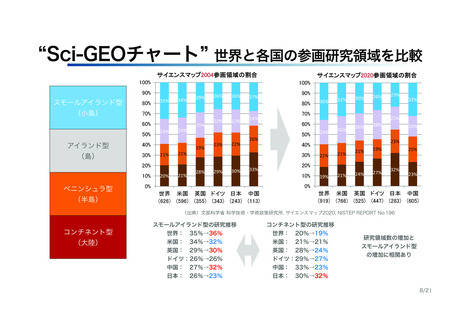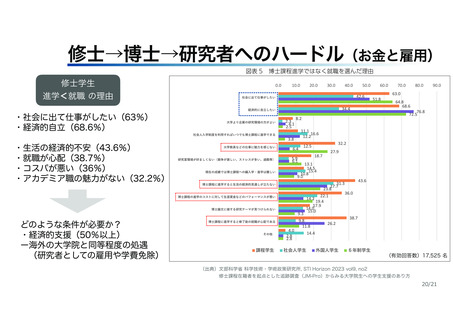よむ、つかう、まなぶ。
ライフサイエンス研究の挑戦:-日本の研究力向上の鍵となる多様性の力-(倉永教授発表資料) (2 ページ)
出典
| 公開元URL | https://www.lifescience.mext.go.jp/2024/01/111060116.html |
| 出典情報 | 科学技術・学術審議会 研究計画・評価分科会 ライフサイエンス委員会 (第111回 1/16)《文部科学省》 |
ページ画像
ダウンロードした画像を利用する際は「出典情報」を明記してください。
低解像度画像をダウンロード
プレーンテキスト
資料テキストはコンピュータによる自動処理で生成されており、完全に資料と一致しない場合があります。
テキストをコピーしてご利用いただく際は資料と付け合わせてご確認ください。
研究力の向上にむけて
なぜ、日本の研究力低下がクローズアップされたか?
he says (see ‘Steady but slipping’).
Some of the decline might be attributable
to funding, Igami says. The 2023 report shows
that research spending in the university sector
has grown by roughly 80% in the United States
and Germany, and by 40% in France; quadrupled in South Korea; and increased tenfold in
China over the past two decades. By contrast,
Japan’s spending has increased by 10%.
However, even if Japan’s researchers receive
more funding, producing high-impact work
might still be challenging, because they are
spending less time on actual research, Igami
says. According to a 2020 analysis by MEXT, the
proportion of time that university researchers
dedicated to science decreased from 47% to
33% between 2002 and 2018.
“University researchers are increasingly
expected to take on diverse roles in teaching, industry collaborations and community
engagement. In medicine, junior researchers
are dedicating more time to clinical duties to
maintain hospital revenue,” says Igami. “While
there are benefits to universities contributing
to the wider society in diverse ways, it limits
the time available for research.”
The report’s findings confirm those of a
previous survey of early-career researchers,
which pointed to a lack of time for research
as a notable factor in job dissatisfaction (see
go.nature.com/4ojrvuj). Haruka Ono, a civil
engineer at the Toyohashi University of Technology in Japan, who was part of the group that
conducted the survey, says that respondents
found administration too onerous.
“Anything from visa paperwork for foreign
lab members, to taking calls from landlords
claiming that your students aren’t paying rent
on time — that’s your responsibility if you are
a principal investigator,” she says.
To secure more research time, Wataru
Iwasaki, a computational biologist at the University of Tokyo, who represents early-career
researchers at the Science Council of Japan,
would like to see more support staff, including
administrative personnel and laboratory techniciansaswellasthosewithbusinessexpertiseto
facilitatecollaborationswiththeprivatesector.
Currently, Japanese universities have one technicianper20researchers, markedlyfewerthan
other countries included in the 2023 report.
Having more support staff would also
increase the trend of moving away from the
hierarchical laboratory models prevalent in
SLIPPING DOWN
Although Japan was ranked fifth globally in terms of output of scientific
papers in 2019–21, it ranked 13th on measures of quality output.
PAPERS PUBLISHED IN 2019–21
China
United States
India
☆Natureの記事
Germany
Japan
United Kingdom
・top10%論文数の順位が下位
・論文総数の割合が低下
Italy
South Korea
France
Canada
Brazil
Spain
Australia
0
100
200
300
400
500
Number of papers (thousands)
PAPERS IN THE TOP 10% OF MOST-CITED ARTICLES IN 2019–21
China
目標:
・top10%論文を増やす
・論文総数を増やす
United States
United Kingdom
Germany
Italy
India
Australia
Canada
France
South Korea
Spain
Iran
Japan
0
10
20
30
40
50
60
Number of papers (thousands)
STEADY BUT SLIPPING
解決策?:
・top10%論文を“増やせる”研究領域/研究者に予算
・論文総数を“増やせる”以下同文
Japan’s output of scientific papers has stayed steady over time, hovering at around 65,000 papers published in
2008–10 and in 2018–20. But its overall share of papers published globally has slipped from 6% to below 4%.
2008–10
→“選択と集中”で良いか?
2/21
0
5
10
15
Share of papers published globally (%)
2018–20
20
25
なぜ、日本の研究力低下がクローズアップされたか?
he says (see ‘Steady but slipping’).
Some of the decline might be attributable
to funding, Igami says. The 2023 report shows
that research spending in the university sector
has grown by roughly 80% in the United States
and Germany, and by 40% in France; quadrupled in South Korea; and increased tenfold in
China over the past two decades. By contrast,
Japan’s spending has increased by 10%.
However, even if Japan’s researchers receive
more funding, producing high-impact work
might still be challenging, because they are
spending less time on actual research, Igami
says. According to a 2020 analysis by MEXT, the
proportion of time that university researchers
dedicated to science decreased from 47% to
33% between 2002 and 2018.
“University researchers are increasingly
expected to take on diverse roles in teaching, industry collaborations and community
engagement. In medicine, junior researchers
are dedicating more time to clinical duties to
maintain hospital revenue,” says Igami. “While
there are benefits to universities contributing
to the wider society in diverse ways, it limits
the time available for research.”
The report’s findings confirm those of a
previous survey of early-career researchers,
which pointed to a lack of time for research
as a notable factor in job dissatisfaction (see
go.nature.com/4ojrvuj). Haruka Ono, a civil
engineer at the Toyohashi University of Technology in Japan, who was part of the group that
conducted the survey, says that respondents
found administration too onerous.
“Anything from visa paperwork for foreign
lab members, to taking calls from landlords
claiming that your students aren’t paying rent
on time — that’s your responsibility if you are
a principal investigator,” she says.
To secure more research time, Wataru
Iwasaki, a computational biologist at the University of Tokyo, who represents early-career
researchers at the Science Council of Japan,
would like to see more support staff, including
administrative personnel and laboratory techniciansaswellasthosewithbusinessexpertiseto
facilitatecollaborationswiththeprivatesector.
Currently, Japanese universities have one technicianper20researchers, markedlyfewerthan
other countries included in the 2023 report.
Having more support staff would also
increase the trend of moving away from the
hierarchical laboratory models prevalent in
SLIPPING DOWN
Although Japan was ranked fifth globally in terms of output of scientific
papers in 2019–21, it ranked 13th on measures of quality output.
PAPERS PUBLISHED IN 2019–21
China
United States
India
☆Natureの記事
Germany
Japan
United Kingdom
・top10%論文数の順位が下位
・論文総数の割合が低下
Italy
South Korea
France
Canada
Brazil
Spain
Australia
0
100
200
300
400
500
Number of papers (thousands)
PAPERS IN THE TOP 10% OF MOST-CITED ARTICLES IN 2019–21
China
目標:
・top10%論文を増やす
・論文総数を増やす
United States
United Kingdom
Germany
Italy
India
Australia
Canada
France
South Korea
Spain
Iran
Japan
0
10
20
30
40
50
60
Number of papers (thousands)
STEADY BUT SLIPPING
解決策?:
・top10%論文を“増やせる”研究領域/研究者に予算
・論文総数を“増やせる”以下同文
Japan’s output of scientific papers has stayed steady over time, hovering at around 65,000 papers published in
2008–10 and in 2018–20. But its overall share of papers published globally has slipped from 6% to below 4%.
2008–10
→“選択と集中”で良いか?
2/21
0
5
10
15
Share of papers published globally (%)
2018–20
20
25





















